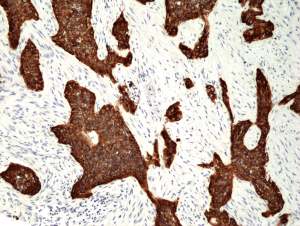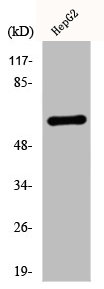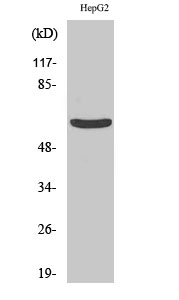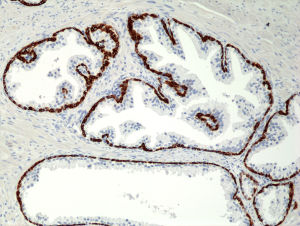
Immunohistochemical staining of formalin fixed and paraffin embedded human Lung Squamous Cell Carcinoma tissue section using anti-CK-5 rabbit monoclonal antibody (Clone RM226) at a 1:200 dilution.
anti-Cytokeratin-5 (human), Rabbit Monoclonal (RM226)
REV-31-1105-00
ApplicationsWestern Blot, ImmunoHistoChemistry
Product group Antibodies
TargetKRT5
Overview
- SupplierRevMAb Biosciences
- Product Nameanti-Cytokeratin-5 (human), Rabbit Monoclonal (RM226)
- Delivery Days Customer10
- ApplicationsWestern Blot, ImmunoHistoChemistry
- CertificationResearch Use Only
- ClonalityMonoclonal
- Clone IDRM226
- Gene ID3852
- Target nameKRT5
- Target descriptionkeratin 5
- Target synonymsCK5, DDD, DDD1, EBS1, EBS2, EBS2A, EBS2B, EBS2C, EBS2D, EBS2E, EBS2F, K5, KRT5A, keratin, type II cytoskeletal 5, 58 kda cytokeratin, CK-5, cytokeratin-5, epidermolysis bullosa simplex 2 Dowling-Meara/Kobner/Weber-Cockayne types, keratin 5 (epidermolysis bullosa simplex, Dowling-Meara/Kobner/Weber-Cockayne types), keratin 5, type II, type-II keratin Kb5
- HostRabbit
- IsotypeIgG
- Protein IDP13647
- Protein NameKeratin, type II cytoskeletal 5
- Scientific DescriptionCytokeratins are keratin proteins found in the intracytoplasmic cytoskeleton of epithelial tissue (at least 20 different polypeptides). They are an important component of intermediate filaments, which help cells resist mechanical stress. Expression of these cytokeratins within epithelial cells is largely specific to particular organs or tissues. The subsets of cytokeratins which an epithelial cell expresses depends mainly on the type of epithelium, the moment in the course of terminal differentiation and the stage of development. Thus a specific cytokeratin expression profile allows the identification of epithelial cells. Furthermore, this applies also to the malignant counterparts of the epithelia, (carcinomas). Cytokeratin subtype expression patterns are used to an increasing extent in the distinction of different types of epithelial malignancies. The cytokeratin antibodies are not only of assistance in the differential diagnosis of tumors using immunohistochemistry on tissue sections, but are also a useful tool in cytopathology and flow cytometric assays. Cytokeratin-5 is a member of the type II (basic or neutral) cytokeratin family. Type II keratins, in general, are heteropolymeric structural proteins coexpressed during differentiation of simple and stratified epithelial tissues. Cytokeratin-5 is specifically expressed in the basal layer of the epidermis along with cytokeratin-14. Cytokeratin-5 serves as a biomarker for several different types of cancer, including breast and lung cancers. The expression of cytokeratin-5 is linked to the intermediate phenotype of cells undergoing the epithelial-mesenchymal transition (EMT). This process has a large role in tumor progression and metastasis since it helps enable tumor cells to travel throughout the body and colonize distant sites. Cytokeratin-5 may therefore be useful in the identification of basal cell metastases. - Recombinant Antibody. This antibody reacts to Human Cytokeratin 5. This antibody may also react to bovine, mouse, or rat Cytokeratin, as predicted by immunogen homology. Applications: WB, IHC. Source: Rabbit. Liquid. 50% Glycerol/PBS with 1% BSA and 0.09% sodium azide. Cytokeratins are keratin proteins found in the intracytoplasmic cytoskeleton of epithelial tissue (at least 20 different polypeptides). They are an important component of intermediate filaments, which help cells resist mechanical stress. Expression of these cytokeratins within epithelial cells is largely specific to particular organs or tissues. The subsets of cytokeratins which an epithelial cell expresses depends mainly on the type of epithelium, the moment in the course of terminal differentiation and the stage of development. Thus a specific cytokeratin expression profile allows the identification of epithelial cells. Furthermore, this applies also to the malignant counterparts of the epithelia, (carcinomas). Cytokeratin subtype expression patterns are used to an increasing extent in the distinction of different types of epithelial malignancies. The cytokeratin antibodies are not only of assistance in the differential diagnosis of tumors using immunohistochemistry on tissue sections, but are also a useful tool in cytopathology and flow cytometric assays. Cytokeratin-5 is a member of the type II (basic or neutral) cytokeratin family. Type II keratins, in general, are heteropolymeric structural proteins coexpressed during differentiation of simple and stratified epithelial tissues. Cytokeratin-5 is specifically expressed in the basal layer of the epidermis along with cytokeratin-14. Cytokeratin-5 serves as a biomarker for several different types of cancer, including breast and lung cancers. The expression of cytokeratin-5 is linked to the intermediate phenotype of cells undergoing the epithelial-mesenchymal transition (EMT). This process has a large role in tumor progression and metastasis since it helps enable tumor cells to travel throughout the body and colonize distant sites. Cytokeratin-5 may therefore be useful in the identification of basal cell metastases.
- Storage Instruction-20°C
- UNSPSC12352203







